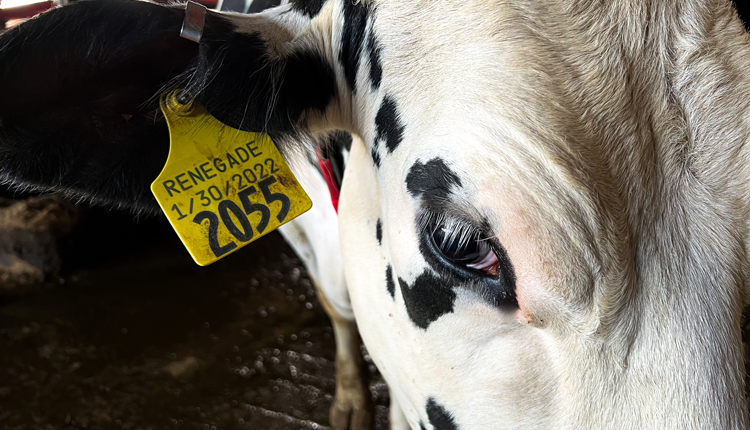"Compared to 1944, milk production per cow is up 443 percent," Dale Bauman told attendees at the Great Lakes Regional Dairy Conference in Frankenmuth, Mich. When using more recent 2011 milk per cow data, that percentage actually climbs to 467 percent as milk production has improved to 21,345 pounds per cow. 
"At the same time, the carbon footprint of a unit of milk produced in 2007 is only 37 percent of that in 1944," he said, citing joint research conducted with Jude Capper and Roger Cady. "We are producing an equal quantity of milk that requires only 21 percent of the animals, 23 percent as much feed, 35 percent of the water, 10 percent of the land area and only 24 percent as much animal waste," said the Liberty Hyde professor emeritus from Cornell University.
To say the least, dairy cows are more efficient than their ancestors.
"In 1944, the average cow utilized 65 percent of her feed intake for dairy maintenance and only 35 percent for milk synthesis," explained Bauman to the Michigan gathering. "Those numbers are essentially reversed in 2007 where the average cow utilized only 33 percent of energy intake for maintenance and 67 percent for milk production," he said. "The net result is that today a gallon of milk can be produced using fewer nutrients, less animal waste and at a lower cost," noted Bauman who was inducted into the National Dairy Shrine's Hall of Fame in 2008.
"Agriculture contributes less than 6 percent of the total U.S. carbon footprint. Animal agriculture is under 3 percent with dairy at 0.7 percent," said Bauman, noting that agriculture is doing its part. Bauman also went on to suggest that the dairy industry should get some carbon credits for feeding by-products from the human food and fiber industry which would further reduce those numbers.
Bauman noted that we cannot rest on our laurels.
"To meet the needs of humankind, we will have to produce as much food in the next 40 years as we have in the history of the world," Bauman said. "On a global basis an estimated 925 million people are undernourished and 16,000 children die from malnutrition each day," he said. "In the U.S., more than 17 million children are at risk of hunger and one in five families are food insecure."
Dairy can play a big role in meeting human nutrition needs. "The 2010 Dietary Guideline for Americans identified dairy products as a major source for four of the seven "nutrients of concern" recognized as being marginal or inadequate in adult diets," said Bauman. "Dairy provides three of the five "nutrients of concern" for children's diets."
Even at current dietary intakes, dairy contributes significant nutrients at a lower percent of calories. "Dairy only contributes 10 percent of dietary calories. However, on a percentage basis it provides: 58 percent of Vitamin D; 51 percent of calcium; 28 percent of Vitamin A and phosphorus; 26 percent of Vitamin B12; 18 percent of protein; 16 percent of zinc and potassium; and 13 percent of magnesium."

"At the same time, the carbon footprint of a unit of milk produced in 2007 is only 37 percent of that in 1944," he said, citing joint research conducted with Jude Capper and Roger Cady. "We are producing an equal quantity of milk that requires only 21 percent of the animals, 23 percent as much feed, 35 percent of the water, 10 percent of the land area and only 24 percent as much animal waste," said the Liberty Hyde professor emeritus from Cornell University.
To say the least, dairy cows are more efficient than their ancestors.
"In 1944, the average cow utilized 65 percent of her feed intake for dairy maintenance and only 35 percent for milk synthesis," explained Bauman to the Michigan gathering. "Those numbers are essentially reversed in 2007 where the average cow utilized only 33 percent of energy intake for maintenance and 67 percent for milk production," he said. "The net result is that today a gallon of milk can be produced using fewer nutrients, less animal waste and at a lower cost," noted Bauman who was inducted into the National Dairy Shrine's Hall of Fame in 2008.
"Agriculture contributes less than 6 percent of the total U.S. carbon footprint. Animal agriculture is under 3 percent with dairy at 0.7 percent," said Bauman, noting that agriculture is doing its part. Bauman also went on to suggest that the dairy industry should get some carbon credits for feeding by-products from the human food and fiber industry which would further reduce those numbers.
Bauman noted that we cannot rest on our laurels.
"To meet the needs of humankind, we will have to produce as much food in the next 40 years as we have in the history of the world," Bauman said. "On a global basis an estimated 925 million people are undernourished and 16,000 children die from malnutrition each day," he said. "In the U.S., more than 17 million children are at risk of hunger and one in five families are food insecure."
Dairy can play a big role in meeting human nutrition needs. "The 2010 Dietary Guideline for Americans identified dairy products as a major source for four of the seven "nutrients of concern" recognized as being marginal or inadequate in adult diets," said Bauman. "Dairy provides three of the five "nutrients of concern" for children's diets."
Even at current dietary intakes, dairy contributes significant nutrients at a lower percent of calories. "Dairy only contributes 10 percent of dietary calories. However, on a percentage basis it provides: 58 percent of Vitamin D; 51 percent of calcium; 28 percent of Vitamin A and phosphorus; 26 percent of Vitamin B12; 18 percent of protein; 16 percent of zinc and potassium; and 13 percent of magnesium."










